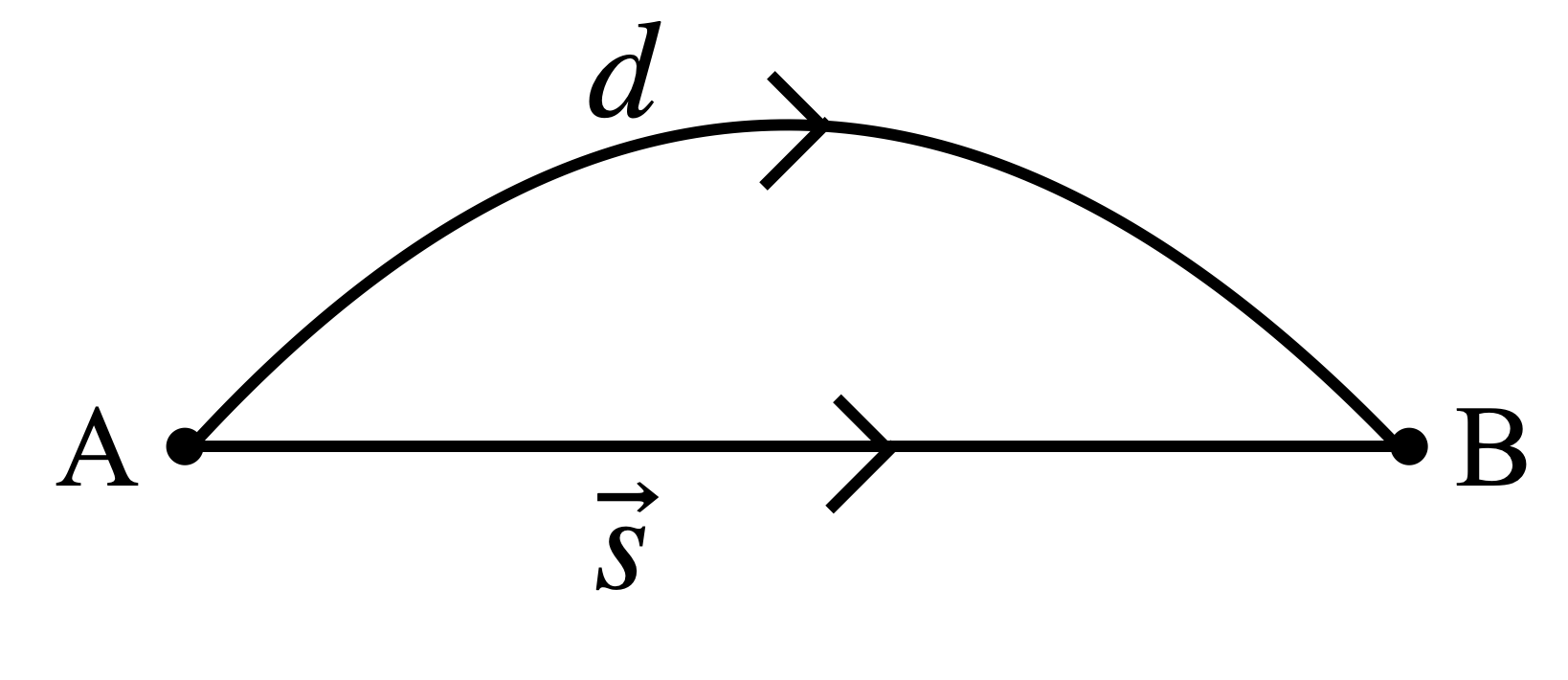
The numerical ratio of displacement to distance covered is always:
A. Less than one
B. Equal to one
C. Equal to or less than one
D. Equal to or greater than one.
Answer
491.4k+ views
Hint: Displacement is calculated along a straight line from initial position to the final position. Take any path which does not connect the starting and ending points directly. Measure the distance travelled using the path. Now, calculate the displacement and compare with the distance travelled.
Complete step by step answer:
First, we need to know the definitions of displacement and distance covered.
Displace is the difference between the final position and initial position. It does not incorporate the path taken to reach the final position.
Distance covered is the distance of the path taken to travel from the initial position to the final position.
Let’s look at the following image to understand the concept in simple terms:

Let’s assume that an object travels from point A to point B in the curved path.
The curved path is a representative of any path which is not aligned with the straight-line AB.
Let’s assume that the distance covered by the object = d.
However, from definition the displacement of the object is always calculated by measuring the length of the straight line connecting the initial and final positions.
Hence, in this case, displacement = s
As we can see in the diagram, the distance covered by the object will always be more than the straight-line connecting points A and B. Because AB is the shortest path possible.
Displacement and distance covered by the particle will be equal only when it maintains the path AB and it does not change its direction of motion.
So, we can say for sure that displacement will always be equal or less than the distance covered.
Hence, the ratio of displacement and distance covered will always be equal to or less than one.
So, the correct choice is - (C).
Note: Displacement is a vector quantity as it depends on the relative position of the final and initial points. However, distance covered is a scalar quantity, and it does not depend on the direction of motion.
You need to consider all possible scenarios for a question like these. There can be exceptions and anomalies in the general statement which you need to be careful of.
Complete step by step answer:
First, we need to know the definitions of displacement and distance covered.
Displace is the difference between the final position and initial position. It does not incorporate the path taken to reach the final position.
Distance covered is the distance of the path taken to travel from the initial position to the final position.
Let’s look at the following image to understand the concept in simple terms:

Let’s assume that an object travels from point A to point B in the curved path.
The curved path is a representative of any path which is not aligned with the straight-line AB.
Let’s assume that the distance covered by the object = d.
However, from definition the displacement of the object is always calculated by measuring the length of the straight line connecting the initial and final positions.
Hence, in this case, displacement = s
As we can see in the diagram, the distance covered by the object will always be more than the straight-line connecting points A and B. Because AB is the shortest path possible.
Displacement and distance covered by the particle will be equal only when it maintains the path AB and it does not change its direction of motion.
So, we can say for sure that displacement will always be equal or less than the distance covered.
Hence, the ratio of displacement and distance covered will always be equal to or less than one.
So, the correct choice is - (C).
Note: Displacement is a vector quantity as it depends on the relative position of the final and initial points. However, distance covered is a scalar quantity, and it does not depend on the direction of motion.
You need to consider all possible scenarios for a question like these. There can be exceptions and anomalies in the general statement which you need to be careful of.
Recently Updated Pages
Master Class 11 Accountancy: Engaging Questions & Answers for Success

Express the following as a fraction and simplify a class 7 maths CBSE

The length and width of a rectangle are in ratio of class 7 maths CBSE

The ratio of the income to the expenditure of a family class 7 maths CBSE

How do you write 025 million in scientific notatio class 7 maths CBSE

How do you convert 295 meters per second to kilometers class 7 maths CBSE

Trending doubts
The Equation xxx + 2 is Satisfied when x is Equal to Class 10 Maths

Why is there a time difference of about 5 hours between class 10 social science CBSE

Change the following sentences into negative and interrogative class 10 english CBSE

Write a letter to the principal requesting him to grant class 10 english CBSE

Explain the Treaty of Vienna of 1815 class 10 social science CBSE

Write an application to the principal requesting five class 10 english CBSE




